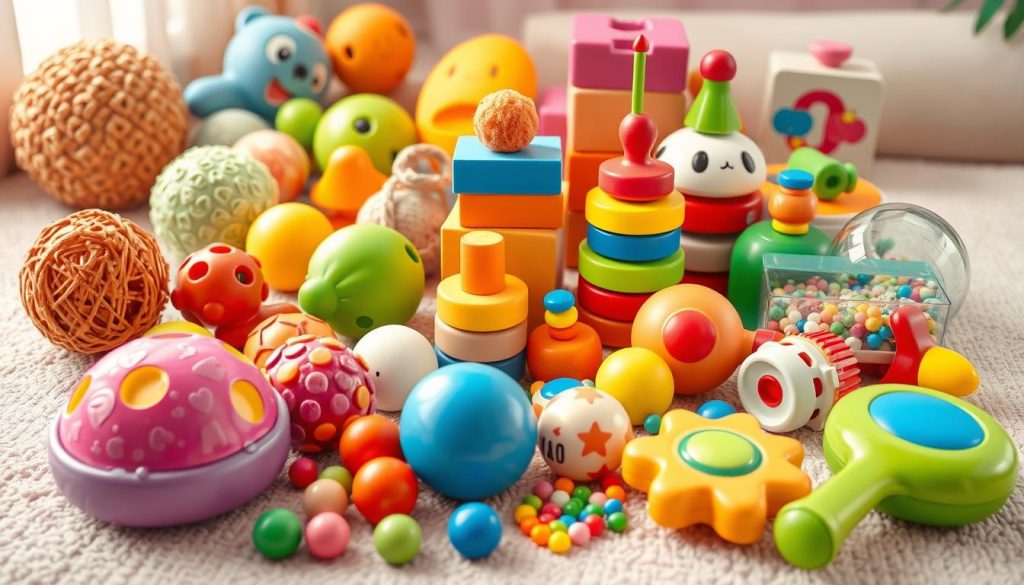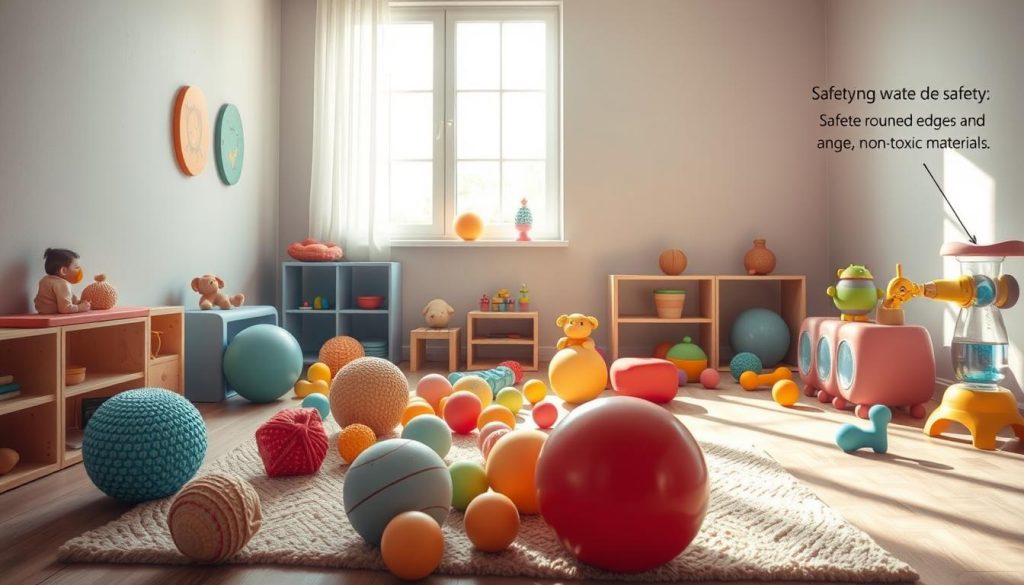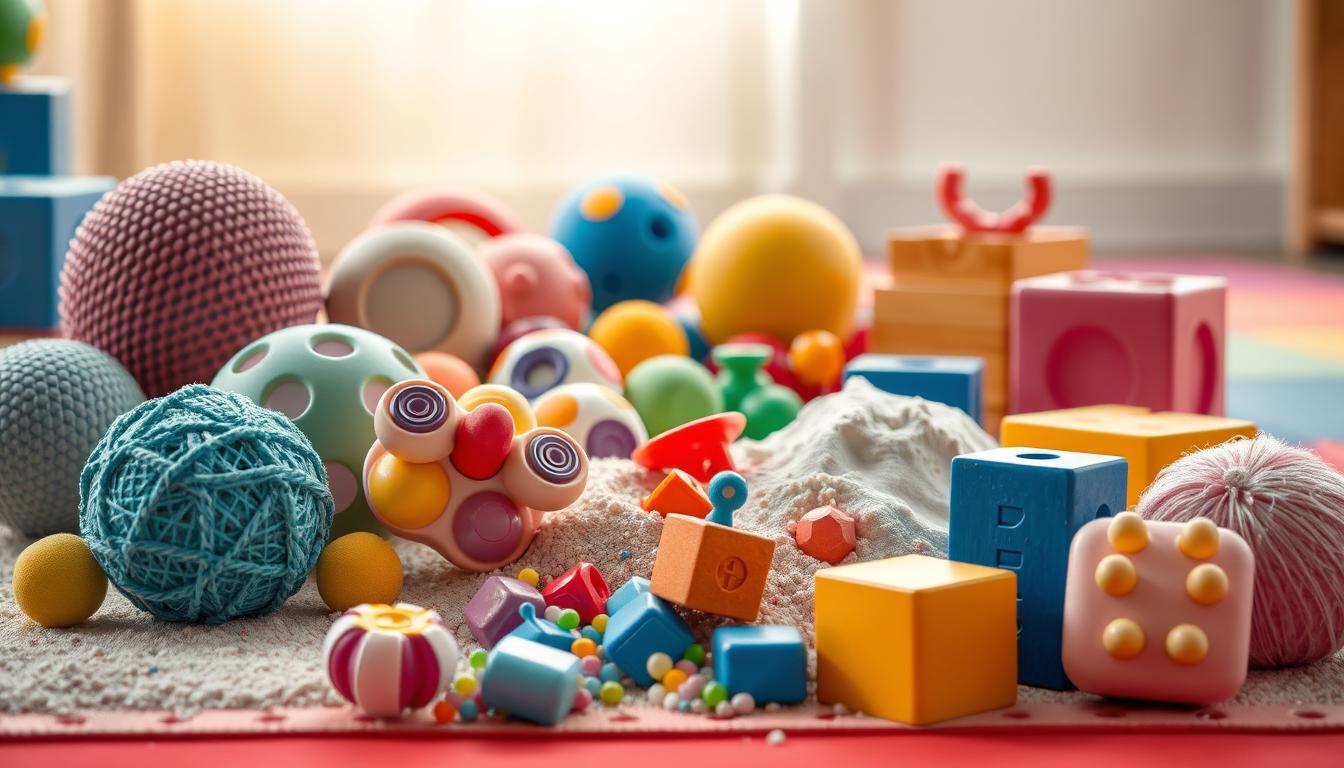In today’s world, engaging children with sensory toys is more important than ever. These toys not only capture young minds but also boost kids’ development. Through sensory play, children can dive into activities that improve their thinking, motor skills, and creativity.
As we explore educational toys, you’ll see how they support emotional well-being. They also help reach important developmental milestones in a fun way.
The Importance of Sensory Play in Child Development
Sensory play is key for a child’s growth. It’s how kids make sense of the world around them. This helps them interact and learn.
Understanding Sensory Processing
Sensory processing is how kids organize and understand sensory information. It’s vital for their learning and growth. By exploring different textures and sounds, kids learn about their world and improve their thinking skills.
Benefits of Sensory Play for Different Age Groups
Sensory play helps kids at every age. For babies, it’s about learning to grasp and move objects. This is crucial for their development.
As kids get older, sensory play becomes even more important. For preschoolers, it’s about learning to share and control their emotions. This helps them understand how to get along with others.
In school, sensory play boosts creativity and problem-solving. Teachers use sensory toys to make learning fun and engaging for all students.
| Age Group | Key Sensory Play Benefits |
|---|---|
| Infants (0-12 months) | Development of fine motor skills through tactile exploration. |
| Toddlers (1-3 years) | Enhancement of cognitive skills through discovery and exploration. |
| Preschoolers (3-5 years) | Improvement of social skills through group sensory activities. |
| School-aged Children (5-12 years) | Fostering creativity and problem-solving skills during structured play. |
Types of Sensory Toys to Consider

Exploring different sensory toys can really help a child grow. Each type meets specific needs, offering touch, sight, and sound experiences. Let’s look at some great sensory toys that can help a child develop.
Tactile Toys for Enhanced Touch Experience
Tactile toys engage the sense of touch, making them key for sensory play. They include sensory balls, textured blocks, and fidget spinners. Each has a unique texture, offering calm or excitement, depending on the child’s needs. Some favorites are:
- Fidget spinners
- Sensory balls
- Textured blocks
Visual and Auditory Stimulation Toys
Visual and auditory toys are crucial for brain and listening skills. Light projectors dazzle with colors, while musical instruments foster a love for sound. These toys enrich a child’s world, encouraging creativity and focus. Some top picks are:
- Light projectors
- Musical instruments
- Colorful spinning toys
Weighted and Therapeutic Sensory Tools
Weighted and therapeutic toys are great for kids with sensory issues or autism. Items like weighted blankets and lap pads help with focus and calm. They offer a comforting pressure, making daily life easier for some children.
| Type of Sensory Tool | Key Features | Benefits |
|---|---|---|
| Tactile Toys | Diverse textures and shapes | Encourages exploration of touch |
| Visual Stimulation Toys | Colorful and dynamic designs | Enhances visual perception |
| Auditory Stimulation Toys | Instruments and sound-producing items | Develops listening and cognitive skills |
| Therapeutic Tools | Weighted designs for calming effects | Improves focus and reduces anxiety |
Choosing the Best Sensory Toys for Your Child

Choosing the right sensory toys for your child is key. Every child is unique, and knowing their sensory needs is crucial. I look at their age, developmental stage, and what sensory experiences they enjoy. This helps me pick toys that encourage exploration and fun.
Assessing Your Child’s Needs and Preferences
It’s important to know what your child likes. I watch how they react to different textures, sounds, and visuals. This helps me understand their preferences. Some kids love squishy toys or sensory bins, while others enjoy toys that light up.
By knowing these preferences, I can create a better sensory play space for them.
Safety Considerations When Selecting Sensory Toys
Safety is a top priority when choosing toys. I look for toys made from non-toxic materials and suitable for their age. This ensures the toys are safe and don’t pose risks. It’s especially important to avoid toys with small parts for young children.
Here are some safety tips to keep in mind:
- Choose age-appropriate toys.
- Look for non-toxic and BPA-free materials.
- Avoid small parts that may pose choking hazards.
- Check for safety certifications from recognized organizations.
By following these guidelines, I can make sure my child has a safe and fun play experience.
| Consideration | Importance |
|---|---|
| Age Appropriateness | Ensures safe and suitable play experiences. |
| Material Safety | Avoids harmful substances and toxins. |
| Size of Toys | Prevents choking hazards for younger children. |
| Safety Certification | Provides assurance of tested safety standards. |
How Sensory Toys Aid in Autism Development

Sensory toys play a big role in helping kids with autism. They help these children focus better, manage their feelings, and get along with others.
Specific Autism Toys and Their Benefits
There are many toys that really help kids with autism. I often recommend:
- Squeeze balls: These toys are great for touching and can help kids feel calmer and more focused.
- Noise-canceling headphones: They help make quiet spaces, which is important for kids in loud places.
- Visual timers: These tools help kids understand time better, making them more independent and regular.
Using these toys can really help kids grow and learn more about their world.
Creating a Sensory-Friendly Environment
It’s important to make a space that’s good for kids with autism. Having set routines and activities at home or school is key. It makes a safe place for them to explore.
What makes a space good for kids with autism includes:
- A quiet area with soft lights and calm decorations for relaxing.
- Many different toys that help with different kinds of play.
- Clear plans for the day so kids know what’s coming.
With the right tools and a good environment, kids can really grow and feel safe. A place filled with toys for autism helps kids learn and grow in amazing ways.
Engaging Activities with Sensory Toys
Adding sensory toys to playtime can lead to fun and learning. Creating sensory bins with rice, beans, or sand is a great idea. These bins let kids explore and learn through touch.
Water play is also great for kids. Activities like pouring and splashing keep them interested. Adding toys or sponges makes it even more fun and helps with fine motor skills.
Art with tactile materials is also rewarding. Using playdough, textured paper, or finger paints boosts creativity. These activities are fun and help kids learn while building social skills.

